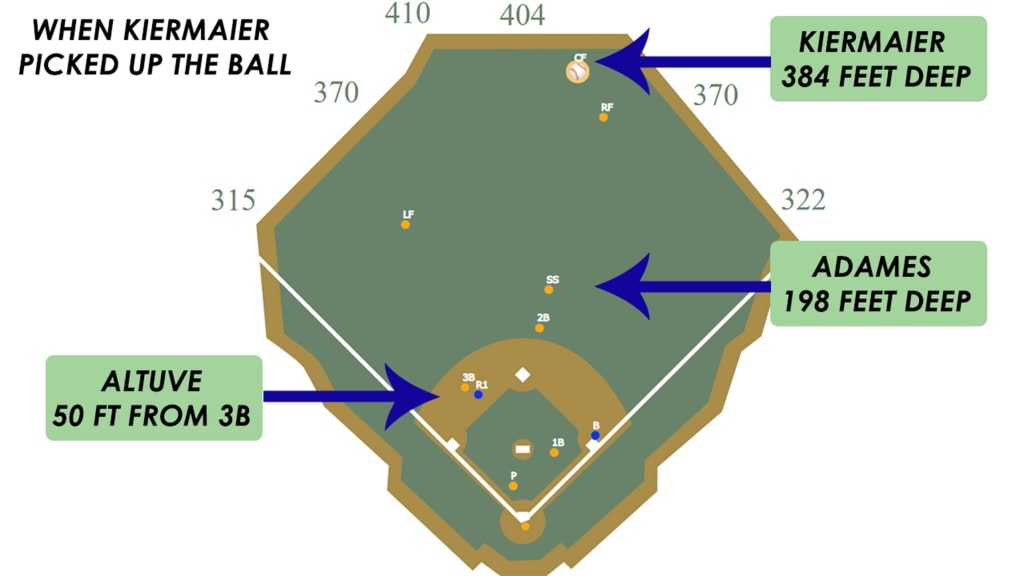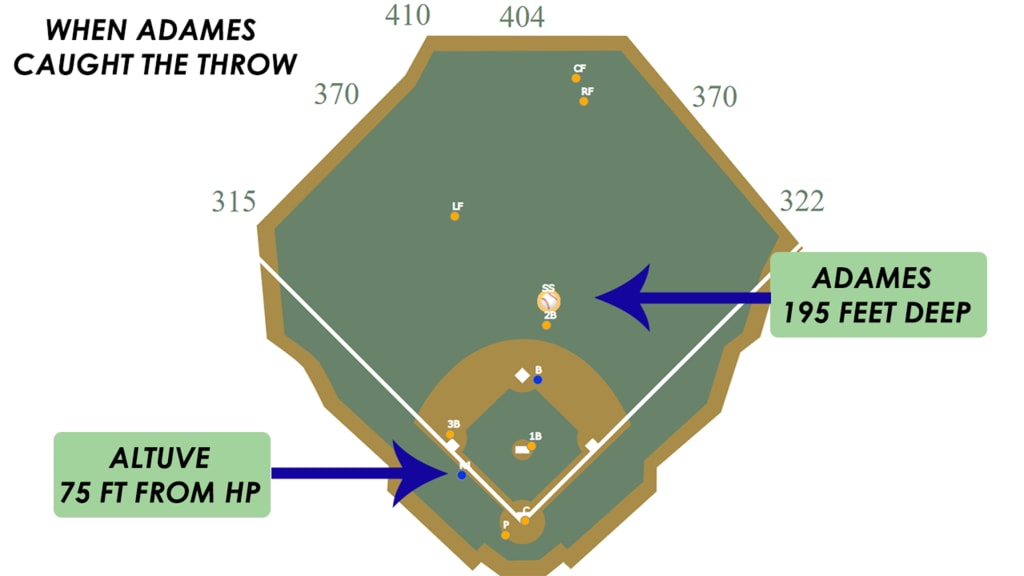"That might be the best relay I've seen," said 12-year Major League veteran Peter Moylan.
"That's as gorgeous a relay throw to the plate as you'll ever see," noted longtime baseball writer and 2019 J.G Taylor Spink Award winner Jayson Stark.
"Probably the most incredible relay throw from an infielder I've ever seen," said the man who started it all, Rays center fielder Kevin Kiermaier.
They're all correct, and they're talking about what the Rays’ defense did to José Altuve in the top of the fourth inning Tuesday night at Tropicana Field during a 4-1 victory over the Astros in Game 4 of the American League Division Series. The win kept Tampa Bay alive for a decisive Game 5 on Thursday night in Houston.
It was one of the finest defensive plays you'll ever see, postseason or not, and it goes without question that we're going to need to break it down to explain just how impressive this was.
To set the scene: Rays are up 3-0 with one out and Altuve on first. It's the top of the fourth, Tampa Bay's offense having already blitzed future Hall of Famer Justin Verlander. Lefty Ryan Yarbrough is pitching, and presumptive AL Rookie of the Year Award winner Yordan Alvarez is at the plate. Alvarez pounds a ball at 113.7 mph off the bat to dead center, near the wall.
Kiermaier picks up the ball and heaves it to shortstop Willy Adames, who sends it to catcher Travis d'Arnaud to get Altuve at the plate. All told, the entire sequence, from Alvarez making contact to d'Arnaud putting down the tag, took 10.4 seconds. From Kiermaier picking up the ball to d'Arnaud tagging Altuve: just five seconds.
Which, all things considered, is not very much. Ten seconds! It will take you 10 seconds to read this line, go check Twitter and return. In this case, 10 seconds might have meant the game and possibly the series. Here's how it went down:
The first 5.4 seconds: Kiermaier gets to the ball
Alvarez, it should be noted, smashed this one. Only 0.3 percent of batted balls -- that's one-third of one percent, or 336 of more than 125,000 batted balls this season -- got up to 113 mph. It's what they call (in scientific terms) "big-boy power."
At the time bat met ball, Altuve was 12 feet off of first base, and he got off to a running start as soon as contact was made. So by the time Kiermaier managed to corral the bounce off the wall, Altuve had rounded second and was just 50 feet away from third base. Just the time the ball was in the air and bouncing around gave him the chance to cover approximately 120 feet around the bases.
(We say "approximately" for him because no one runs in straight, direct 90 degree lines on the bases, and we're adding a few extra feet to the direct-path 118 feet he otherwise would have needed.)
Altuve was moving, too -- his sprint speed on the play was 29.8 feet per second, well above the Major League average of 27, though it should be noted that this would have only barely just made his personal top 50 for the season. He made it from second to third in 3.48 seconds, his fifth-fastest time this year. So Altuve was moving, but he also wasn't doing something we'd never seen him do before.
At the point the ball lands in Kiermaier's glove, he's 384 feet from home, while Altuve is 50 feet from third base and about 145 from home plate, again giving a few extra for rounding the base. You can see what that look liked here:

This helps explain why the Astros sent Altuve, for what it's worth. They needed the run, and Tampa Bay's pitching is so strong that stringing together a bunch of hits for a rally may not have been the most likely outcome in the world. Kiermaier was a mile away, and the ball was about two-and-a-half times farther away than Altuve was. Strong as Kiermaier's arm is, he's not making a 384-foot throw to home on his own, so a relay was necessary, and that means you're mentally making the bet that Altuve can get home before the Rays can make two perfect throws from long distance.
They did, of course. But let's bring in the math here to explain the real decision here:
1. From where Altuve was when Kiermaier picked up the ball, he would have been expected to require five seconds to get to the plate.
That's based on 145 feet remaining times 29.8 feet per second, which is 4.86 seconds, plus a small demerit for time required to decelerate and accelerate rounding third; in reality, it took him 5.04 seconds, so this is right on.
That's one side of it. Here's the other side:
2. In the same five seconds, the Rays needed to make two on-target throws, including the exchange times of unleashing those throws.
Which breaks down like so:
• Kiermaier could be expected to take about 0.75 seconds to throw the ball.
• Kiermaier's average arm strength on 'competitive' throws this year was 95.8 mph, though he topped out at 100.6 mph earlier in the season. He was 186 feet away from Adames, but the throw loses about 10 percent of its velocity every 60 feet, and if we recreate the calculations shown here by MLB.com's Tom Tango, we'll find Kiermaier's throw should take 1.5 seconds.
• Adames could be expected to take about 0.75 seconds to throw the ball.
• Adames has a somewhat lower average arm strength, 86.5 mph, though he topped out at 96.2 mph, and he was actually farther away than Kiermaier was, at 195 feet. Using the same calculation, you'd expect 1.8 seconds for him.
So at the time Kiermaier got the ball, you'd expect it would take five seconds for Altuve to score... and 4.8 seconds for the relay throws to reach the plate -- _if_ they're both placed perfectly. Even the slightest bobble or off-target throw ruins the entire thing. That's the gamble here, that the Rays couldn't do it all perfectly, and that's a perfectly reasonable gamble for Houston to take.
That's what math says might have happened, anyway. So how'd it really go?
The next 2.4 seconds: Kiermaier to Adames
"I knew Alvarez hit it really well," Kiermaier said on the FS1 postgame show. "It actually short-hopped the wall, so it had a big bounce and it just seemed like it was staying up there forever. With Altuve's speed, I knew they were probably going to send him, and I just wanted to make a good strong throw to the cutoff guy, and Adames made ... probably the most incredible relay throw from an infielder I've ever seen."
It indeed took 0.77 seconds for Kiermaier to unleash his throw (87.6 mph), during which time Altuve had covered another 20 feet, leaving him just 30 feet away from third. (Twenty feet is a lot! When you hear "every second counts," realize that it's really "every fraction of a second counts.") You can see him closing in on third base as Kiermaier unleashes the throw.
Then, 1.6 seconds later -- good guess on the 1.5, math -- Adames caught the perfectly on-target throw. Altuve had rounded third and was just 75 feet from home; Adames had barely moved and was still 195 feet away from home plate.

The final 2.8 seconds: Adames to d'Arnaud
Like Kiermaier, Adames took about three-quarters of a second to get the throw off (0.73 seconds, to be exact), and again, that turnaround time allowed Altuve to get nearly 20 feet closer (18 feet, to be exact), leaving us with this scenario: Adames 195 feet away and Altuve 57 feet away.
Adames' on-target throw to d'Arnaud took all of 1.6 seconds, somewhat better than the 1.8 we anticipated, giving the catcher a fraction of a second to place the tag on Altuve, who still had 13 feet to go.
"I think Yordan hit the ball too hard," said Altuve, as reporters chuckled at the comment. "No, I’m serious. It bounced back to Kiermaier, he’s a Gold Glove, he made a good play, and they made a good relay."
Perhaps so, though a slower rocket might have given Kiermaier a chance to catch it in a way he didn't have here. But the point stands: a fraction of a second here, a tenth of a second there. It all matters. It all matters so much.
Going back to our original estimates, we said five seconds for Altuve after Kiermaier got the ball, and it took him 5.04 seconds. We’d said 4.8 seconds for the Rays to get the throw home if the relays were both perfect -- they were, again, which we cannot overemphasize -- and it was actually 4.7 seconds to the catcher. The takeaway here isn’t that third-base coach Gary Pettis was wrong in predicting how long this might all take, because he wasn’t. It was that this was only going to work if the Rays were perfect, and they were.
If this all sounds familiar, it should. Two years ago, in Game 2 of the 2017 AL Championship Series, the Astros won an important game when Carlos Correa's walk-off double scored Altuve, of all people, from first. (But as we pointed out at the time, Altuve was out by 25 feet, or he would have been if Yankees catcher Gary Sanchez had been able to hold onto the ball.)
As FanGraphs noted after Tuesday’s game, the Astros would have had similar odds to win the game if Altuve had scored (30 percent) or stopped at third (28 percent), because there's only so much “not scoring a run” can do to help you when you're the road team down three, but having him thrown out sent those chances down to just 18 percent. Still, that's a tough road uphill either way, and you can certainly understand what Pettis was thinking here.
"We were having a hard time offensively," Houston manager AJ Hinch correctly pointed out, "so it would have been nice to score there when you get thrown out by a fraction of an inch."
"Sometimes you have to give credit to the other team," said Altuve. "They played beautiful defense, especially in that play right there."
"That was such a huge moment for us, huge momentum shift," Kiermaier said, "and it just doesn't get any better than that."
Kiermaier is right. It doesn't get better than that, and it's a big part of why the Rays remain alive.
